Report: Cadbury's Management Operations, Leadership and Theories
VerifiedAdded on 2020/10/22
|16
|4943
|94
Report
AI Summary
This report provides a comprehensive analysis of Cadbury's management operations, exploring its organizational structure and leadership dynamics. It delves into the roles of managers and leaders, comparing their characteristics and responsibilities within the organization. The report examines various management theories, including scientific and human relations theories, to analyze managerial functions and leadership roles. It presents examples of how leaders and managers address organizational conflicts and crises. Furthermore, the report discusses the application of situational leadership and other management theories to support Cadbury's growth and sustainable performance. The analysis covers operational efficiency, the impact of the business environment, and offers recommendations for future improvements, providing a holistic view of Cadbury's management strategies and their effectiveness.
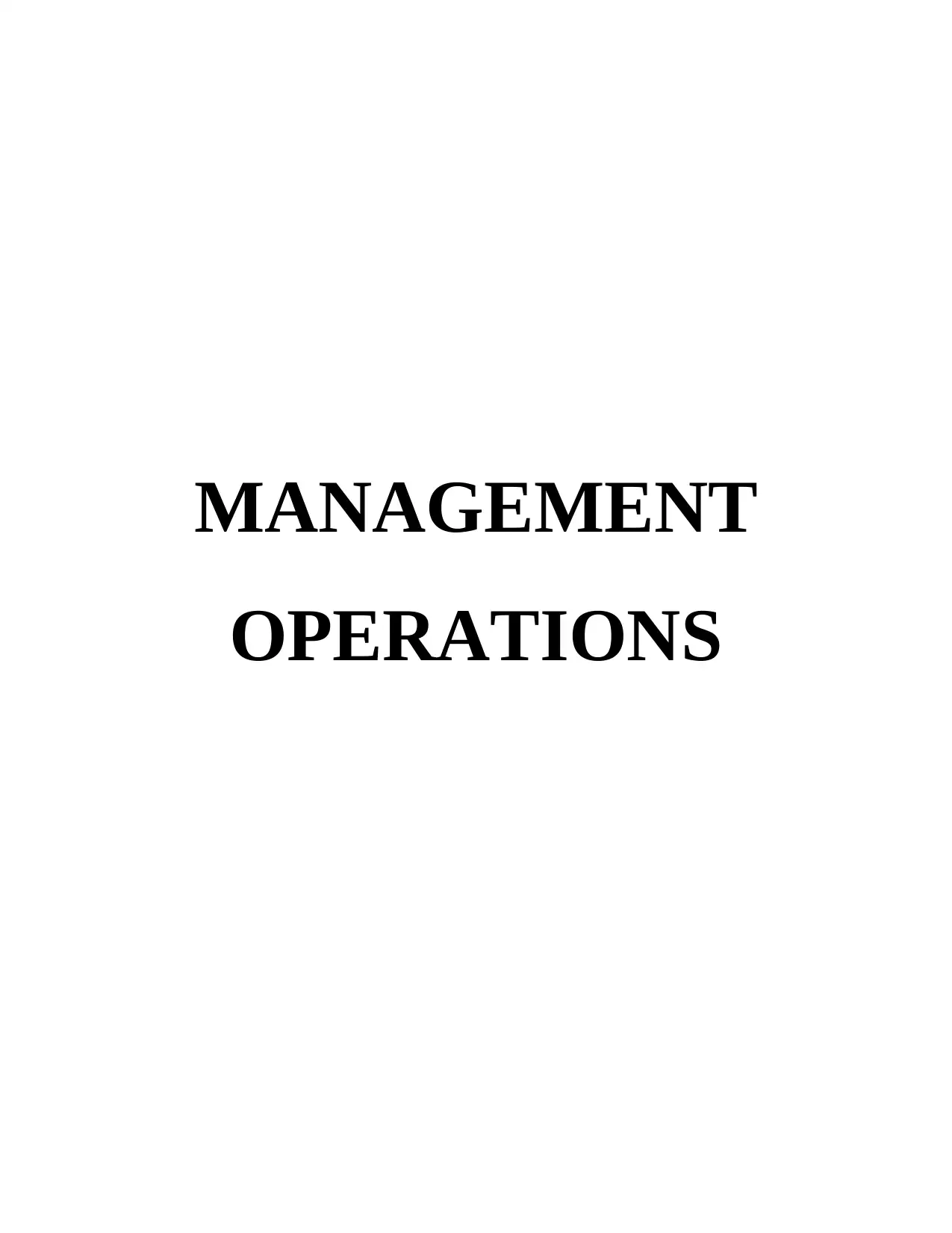
MANAGEMENT
OPERATIONS
OPERATIONS
Paraphrase This Document
Need a fresh take? Get an instant paraphrase of this document with our AI Paraphraser
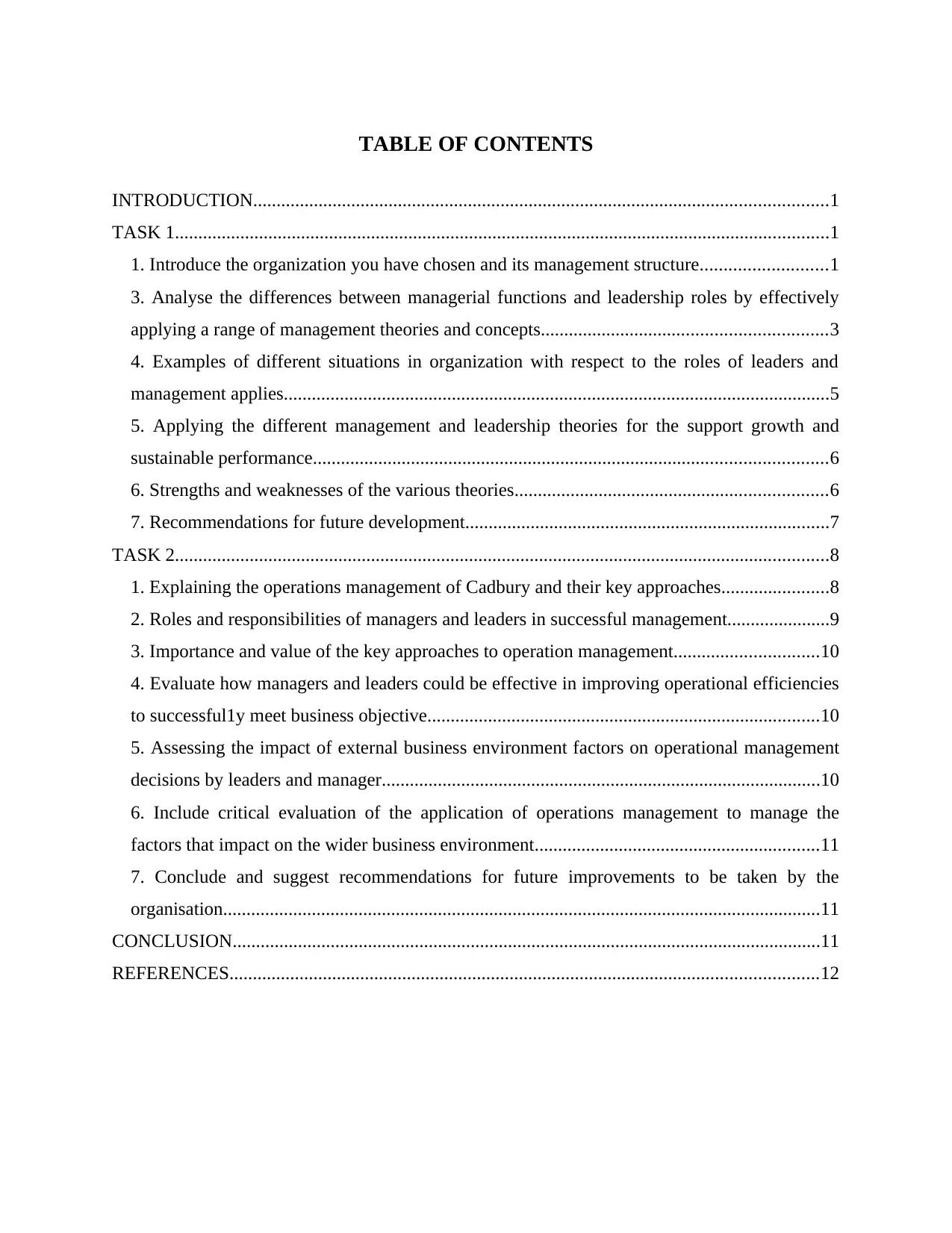
TABLE OF CONTENTS
INTRODUCTION...........................................................................................................................1
TASK 1............................................................................................................................................1
1. Introduce the organization you have chosen and its management structure...........................1
3. Analyse the differences between managerial functions and leadership roles by effectively
applying a range of management theories and concepts.............................................................3
4. Examples of different situations in organization with respect to the roles of leaders and
management applies.....................................................................................................................5
5. Applying the different management and leadership theories for the support growth and
sustainable performance..............................................................................................................6
6. Strengths and weaknesses of the various theories...................................................................6
7. Recommendations for future development..............................................................................7
TASK 2............................................................................................................................................8
1. Explaining the operations management of Cadbury and their key approaches.......................8
2. Roles and responsibilities of managers and leaders in successful management......................9
3. Importance and value of the key approaches to operation management...............................10
4. Evaluate how managers and leaders could be effective in improving operational efficiencies
to successful1y meet business objective....................................................................................10
5. Assessing the impact of external business environment factors on operational management
decisions by leaders and manager..............................................................................................10
6. Include critical evaluation of the application of operations management to manage the
factors that impact on the wider business environment.............................................................11
7. Conclude and suggest recommendations for future improvements to be taken by the
organisation................................................................................................................................11
CONCLUSION..............................................................................................................................11
REFERENCES..............................................................................................................................12
INTRODUCTION...........................................................................................................................1
TASK 1............................................................................................................................................1
1. Introduce the organization you have chosen and its management structure...........................1
3. Analyse the differences between managerial functions and leadership roles by effectively
applying a range of management theories and concepts.............................................................3
4. Examples of different situations in organization with respect to the roles of leaders and
management applies.....................................................................................................................5
5. Applying the different management and leadership theories for the support growth and
sustainable performance..............................................................................................................6
6. Strengths and weaknesses of the various theories...................................................................6
7. Recommendations for future development..............................................................................7
TASK 2............................................................................................................................................8
1. Explaining the operations management of Cadbury and their key approaches.......................8
2. Roles and responsibilities of managers and leaders in successful management......................9
3. Importance and value of the key approaches to operation management...............................10
4. Evaluate how managers and leaders could be effective in improving operational efficiencies
to successful1y meet business objective....................................................................................10
5. Assessing the impact of external business environment factors on operational management
decisions by leaders and manager..............................................................................................10
6. Include critical evaluation of the application of operations management to manage the
factors that impact on the wider business environment.............................................................11
7. Conclude and suggest recommendations for future improvements to be taken by the
organisation................................................................................................................................11
CONCLUSION..............................................................................................................................11
REFERENCES..............................................................................................................................12
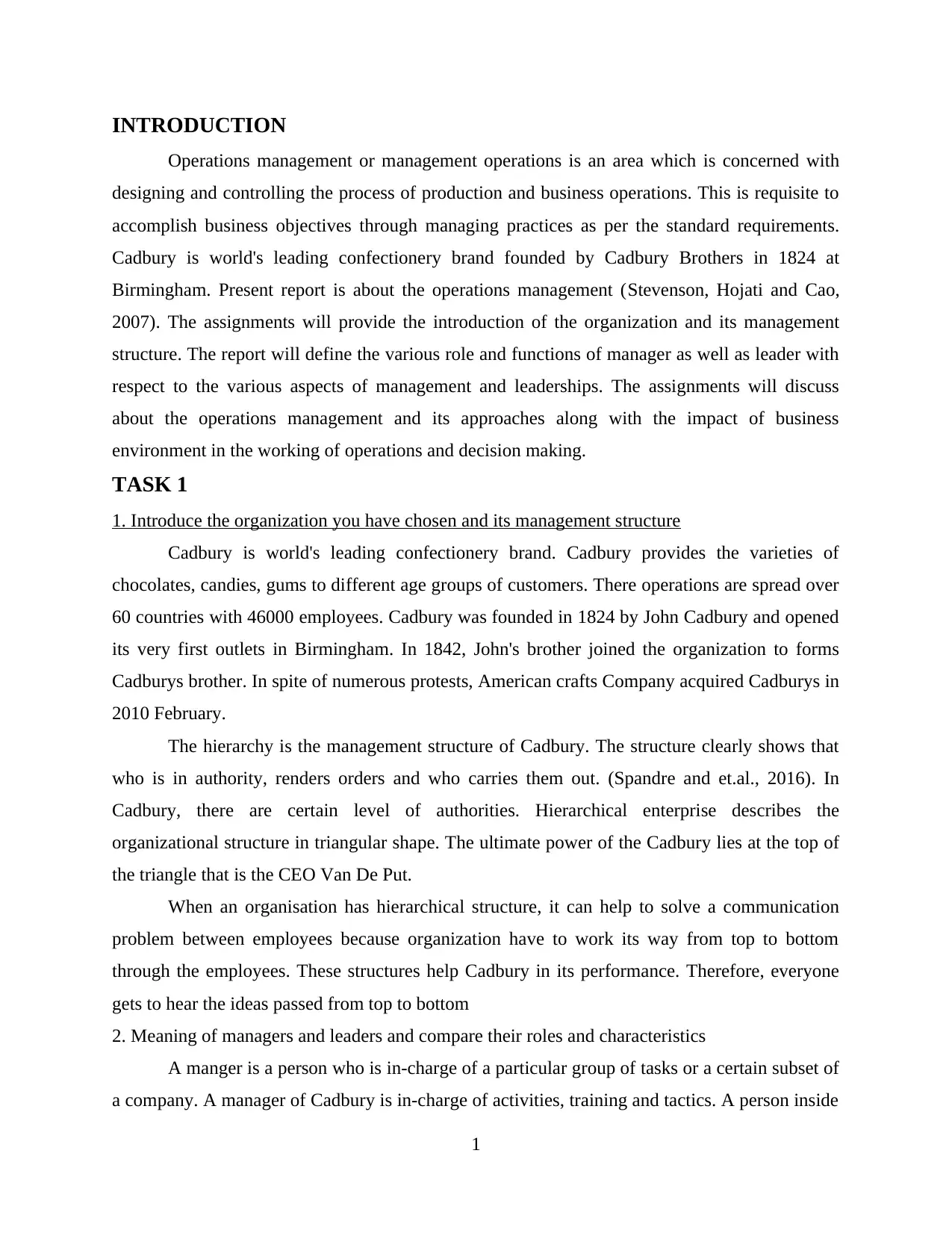
INTRODUCTION
Operations management or management operations is an area which is concerned with
designing and controlling the process of production and business operations. This is requisite to
accomplish business objectives through managing practices as per the standard requirements.
Cadbury is world's leading confectionery brand founded by Cadbury Brothers in 1824 at
Birmingham. Present report is about the operations management (Stevenson, Hojati and Cao,
2007). The assignments will provide the introduction of the organization and its management
structure. The report will define the various role and functions of manager as well as leader with
respect to the various aspects of management and leaderships. The assignments will discuss
about the operations management and its approaches along with the impact of business
environment in the working of operations and decision making.
TASK 1
1. Introduce the organization you have chosen and its management structure
Cadbury is world's leading confectionery brand. Cadbury provides the varieties of
chocolates, candies, gums to different age groups of customers. There operations are spread over
60 countries with 46000 employees. Cadbury was founded in 1824 by John Cadbury and opened
its very first outlets in Birmingham. In 1842, John's brother joined the organization to forms
Cadburys brother. In spite of numerous protests, American crafts Company acquired Cadburys in
2010 February.
The hierarchy is the management structure of Cadbury. The structure clearly shows that
who is in authority, renders orders and who carries them out. (Spandre and et.al., 2016). In
Cadbury, there are certain level of authorities. Hierarchical enterprise describes the
organizational structure in triangular shape. The ultimate power of the Cadbury lies at the top of
the triangle that is the CEO Van De Put.
When an organisation has hierarchical structure, it can help to solve a communication
problem between employees because organization have to work its way from top to bottom
through the employees. These structures help Cadbury in its performance. Therefore, everyone
gets to hear the ideas passed from top to bottom
2. Meaning of managers and leaders and compare their roles and characteristics
A manger is a person who is in-charge of a particular group of tasks or a certain subset of
a company. A manager of Cadbury is in-charge of activities, training and tactics. A person inside
1
Operations management or management operations is an area which is concerned with
designing and controlling the process of production and business operations. This is requisite to
accomplish business objectives through managing practices as per the standard requirements.
Cadbury is world's leading confectionery brand founded by Cadbury Brothers in 1824 at
Birmingham. Present report is about the operations management (Stevenson, Hojati and Cao,
2007). The assignments will provide the introduction of the organization and its management
structure. The report will define the various role and functions of manager as well as leader with
respect to the various aspects of management and leaderships. The assignments will discuss
about the operations management and its approaches along with the impact of business
environment in the working of operations and decision making.
TASK 1
1. Introduce the organization you have chosen and its management structure
Cadbury is world's leading confectionery brand. Cadbury provides the varieties of
chocolates, candies, gums to different age groups of customers. There operations are spread over
60 countries with 46000 employees. Cadbury was founded in 1824 by John Cadbury and opened
its very first outlets in Birmingham. In 1842, John's brother joined the organization to forms
Cadburys brother. In spite of numerous protests, American crafts Company acquired Cadburys in
2010 February.
The hierarchy is the management structure of Cadbury. The structure clearly shows that
who is in authority, renders orders and who carries them out. (Spandre and et.al., 2016). In
Cadbury, there are certain level of authorities. Hierarchical enterprise describes the
organizational structure in triangular shape. The ultimate power of the Cadbury lies at the top of
the triangle that is the CEO Van De Put.
When an organisation has hierarchical structure, it can help to solve a communication
problem between employees because organization have to work its way from top to bottom
through the employees. These structures help Cadbury in its performance. Therefore, everyone
gets to hear the ideas passed from top to bottom
2. Meaning of managers and leaders and compare their roles and characteristics
A manger is a person who is in-charge of a particular group of tasks or a certain subset of
a company. A manager of Cadbury is in-charge of activities, training and tactics. A person inside
1
⊘ This is a preview!⊘
Do you want full access?
Subscribe today to unlock all pages.

Trusted by 1+ million students worldwide
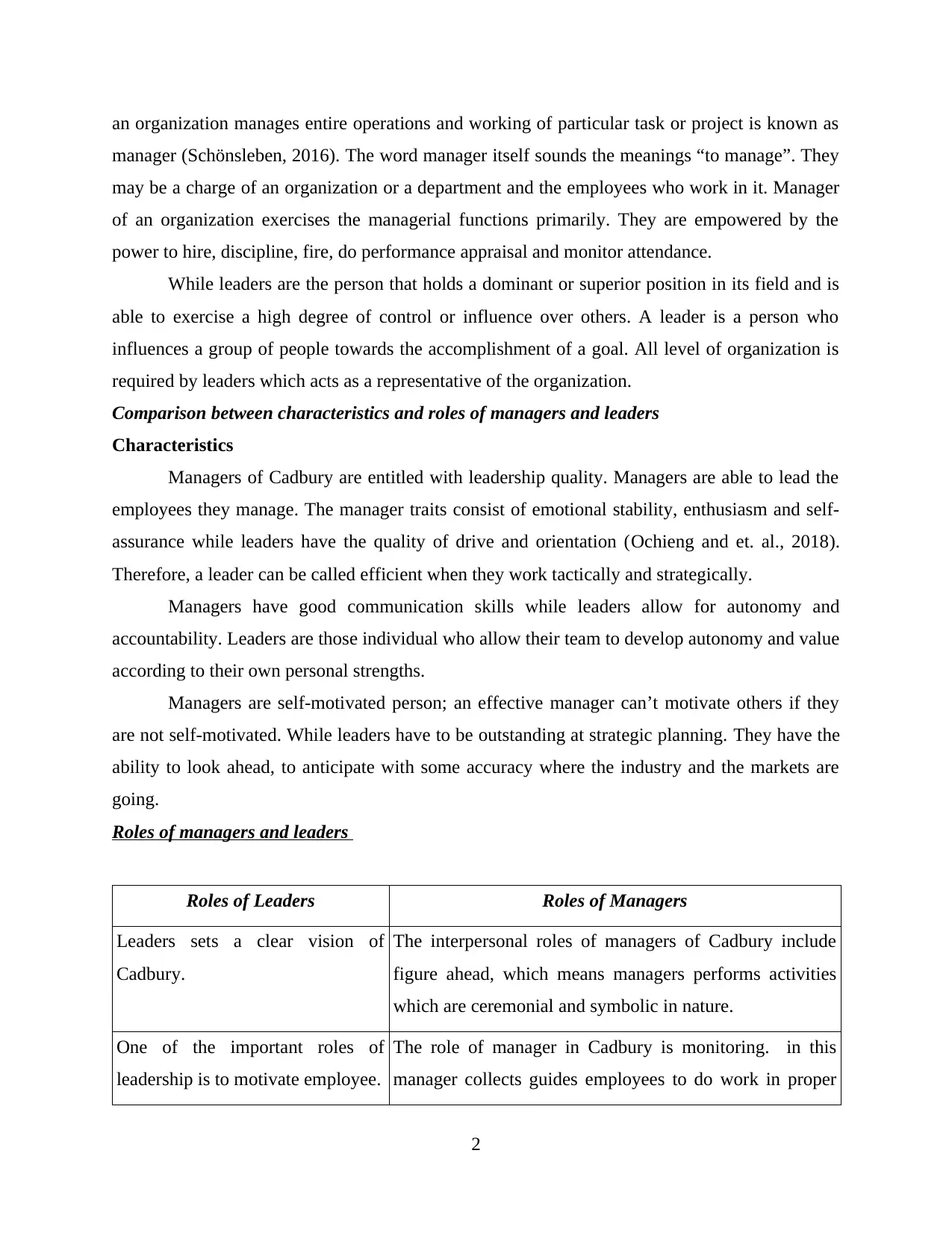
an organization manages entire operations and working of particular task or project is known as
manager (Schönsleben, 2016). The word manager itself sounds the meanings “to manage”. They
may be a charge of an organization or a department and the employees who work in it. Manager
of an organization exercises the managerial functions primarily. They are empowered by the
power to hire, discipline, fire, do performance appraisal and monitor attendance.
While leaders are the person that holds a dominant or superior position in its field and is
able to exercise a high degree of control or influence over others. A leader is a person who
influences a group of people towards the accomplishment of a goal. All level of organization is
required by leaders which acts as a representative of the organization.
Comparison between characteristics and roles of managers and leaders
Characteristics
Managers of Cadbury are entitled with leadership quality. Managers are able to lead the
employees they manage. The manager traits consist of emotional stability, enthusiasm and self-
assurance while leaders have the quality of drive and orientation (Ochieng and et. al., 2018).
Therefore, a leader can be called efficient when they work tactically and strategically.
Managers have good communication skills while leaders allow for autonomy and
accountability. Leaders are those individual who allow their team to develop autonomy and value
according to their own personal strengths.
Managers are self-motivated person; an effective manager can’t motivate others if they
are not self-motivated. While leaders have to be outstanding at strategic planning. They have the
ability to look ahead, to anticipate with some accuracy where the industry and the markets are
going.
Roles of managers and leaders
Roles of Leaders Roles of Managers
Leaders sets a clear vision of
Cadbury.
The interpersonal roles of managers of Cadbury include
figure ahead, which means managers performs activities
which are ceremonial and symbolic in nature.
One of the important roles of
leadership is to motivate employee.
The role of manager in Cadbury is monitoring. in this
manager collects guides employees to do work in proper
2
manager (Schönsleben, 2016). The word manager itself sounds the meanings “to manage”. They
may be a charge of an organization or a department and the employees who work in it. Manager
of an organization exercises the managerial functions primarily. They are empowered by the
power to hire, discipline, fire, do performance appraisal and monitor attendance.
While leaders are the person that holds a dominant or superior position in its field and is
able to exercise a high degree of control or influence over others. A leader is a person who
influences a group of people towards the accomplishment of a goal. All level of organization is
required by leaders which acts as a representative of the organization.
Comparison between characteristics and roles of managers and leaders
Characteristics
Managers of Cadbury are entitled with leadership quality. Managers are able to lead the
employees they manage. The manager traits consist of emotional stability, enthusiasm and self-
assurance while leaders have the quality of drive and orientation (Ochieng and et. al., 2018).
Therefore, a leader can be called efficient when they work tactically and strategically.
Managers have good communication skills while leaders allow for autonomy and
accountability. Leaders are those individual who allow their team to develop autonomy and value
according to their own personal strengths.
Managers are self-motivated person; an effective manager can’t motivate others if they
are not self-motivated. While leaders have to be outstanding at strategic planning. They have the
ability to look ahead, to anticipate with some accuracy where the industry and the markets are
going.
Roles of managers and leaders
Roles of Leaders Roles of Managers
Leaders sets a clear vision of
Cadbury.
The interpersonal roles of managers of Cadbury include
figure ahead, which means managers performs activities
which are ceremonial and symbolic in nature.
One of the important roles of
leadership is to motivate employee.
The role of manager in Cadbury is monitoring. in this
manager collects guides employees to do work in proper
2
Paraphrase This Document
Need a fresh take? Get an instant paraphrase of this document with our AI Paraphraser

way.
Leaders guide the employee and
provide them with tools needed to
perform and participate in their
efforts along the way.
The managers act as a disseminator, they allocate
information to their inferior and superiors by sending
circulars, holding meetings and making phone calls.
It builds a morale of its team
members in order to accomplish
common goals of Cadbury.
Manager inside the Cadbury act as an entrepreneur as it
assumes certain risks which may affect the operations
(Mitsuo, and et. al., 2014).
Leaders act as a representative of
the organization.
They work as a conflict handler as they have to take care
of certain disturbance in organization like disputes among
employees and strikes etc.
Leader integrates and reconcile
with personal goals with Cadbury's
goals.
Manager of Cadbury provides the resources and fulfil the
demands of various units in terms of physical, human and
financial resources.
They act as a friend philosopher
and guide.
All the important decisions in an organization are taken by
managers.
3. Analyse the differences between managerial functions and leadership roles by effectively
applying a range of management theories and concepts.
There are four theories of management given by various management gurus. These are -
Scientific management theory by Fredrick Taylor
Bureaucratic management theory by Max Weber
Human relation theory by Elton Mayo
Systems theory by Henry Fayol
Taking two theories for an analysis of management functions and leadership roles in an
organization.
Scientific management theory
This theory was propounded by F. Taylor. This theory of scientific management aimed at
the improvement of economic efficiency specially of labour productivity. Taylor theory focuses
on factors that motivate employees at work. According to theory, money is the best way of
motivating the employee (Koeser and et.al., 2016). This theory imposed that workers should get
3
Leaders guide the employee and
provide them with tools needed to
perform and participate in their
efforts along the way.
The managers act as a disseminator, they allocate
information to their inferior and superiors by sending
circulars, holding meetings and making phone calls.
It builds a morale of its team
members in order to accomplish
common goals of Cadbury.
Manager inside the Cadbury act as an entrepreneur as it
assumes certain risks which may affect the operations
(Mitsuo, and et. al., 2014).
Leaders act as a representative of
the organization.
They work as a conflict handler as they have to take care
of certain disturbance in organization like disputes among
employees and strikes etc.
Leader integrates and reconcile
with personal goals with Cadbury's
goals.
Manager of Cadbury provides the resources and fulfil the
demands of various units in terms of physical, human and
financial resources.
They act as a friend philosopher
and guide.
All the important decisions in an organization are taken by
managers.
3. Analyse the differences between managerial functions and leadership roles by effectively
applying a range of management theories and concepts.
There are four theories of management given by various management gurus. These are -
Scientific management theory by Fredrick Taylor
Bureaucratic management theory by Max Weber
Human relation theory by Elton Mayo
Systems theory by Henry Fayol
Taking two theories for an analysis of management functions and leadership roles in an
organization.
Scientific management theory
This theory was propounded by F. Taylor. This theory of scientific management aimed at
the improvement of economic efficiency specially of labour productivity. Taylor theory focuses
on factors that motivate employees at work. According to theory, money is the best way of
motivating the employee (Koeser and et.al., 2016). This theory imposed that workers should get
3
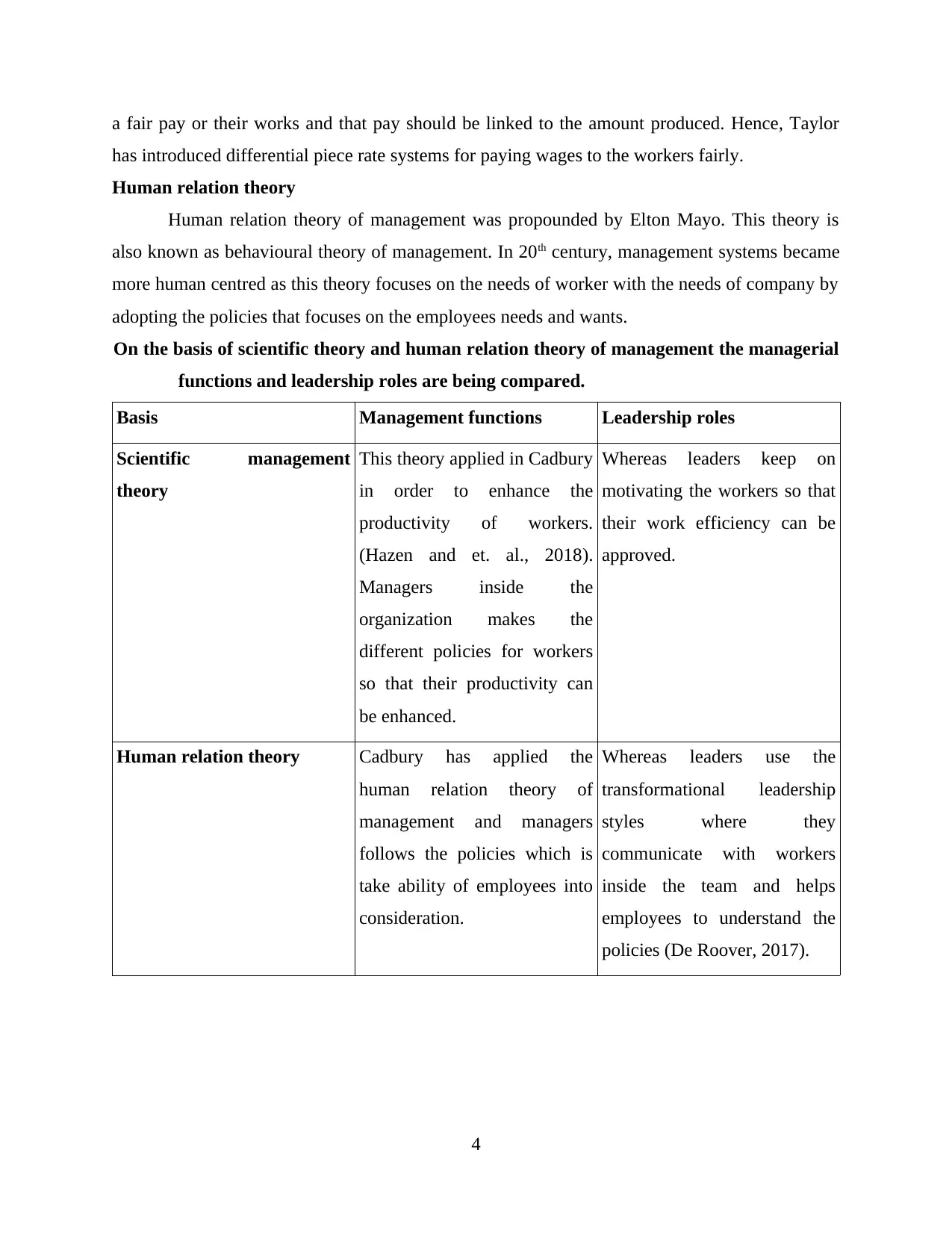
a fair pay or their works and that pay should be linked to the amount produced. Hence, Taylor
has introduced differential piece rate systems for paying wages to the workers fairly.
Human relation theory
Human relation theory of management was propounded by Elton Mayo. This theory is
also known as behavioural theory of management. In 20th century, management systems became
more human centred as this theory focuses on the needs of worker with the needs of company by
adopting the policies that focuses on the employees needs and wants.
On the basis of scientific theory and human relation theory of management the managerial
functions and leadership roles are being compared.
Basis Management functions Leadership roles
Scientific management
theory
This theory applied in Cadbury
in order to enhance the
productivity of workers.
(Hazen and et. al., 2018).
Managers inside the
organization makes the
different policies for workers
so that their productivity can
be enhanced.
Whereas leaders keep on
motivating the workers so that
their work efficiency can be
approved.
Human relation theory Cadbury has applied the
human relation theory of
management and managers
follows the policies which is
take ability of employees into
consideration.
Whereas leaders use the
transformational leadership
styles where they
communicate with workers
inside the team and helps
employees to understand the
policies (De Roover, 2017).
4
has introduced differential piece rate systems for paying wages to the workers fairly.
Human relation theory
Human relation theory of management was propounded by Elton Mayo. This theory is
also known as behavioural theory of management. In 20th century, management systems became
more human centred as this theory focuses on the needs of worker with the needs of company by
adopting the policies that focuses on the employees needs and wants.
On the basis of scientific theory and human relation theory of management the managerial
functions and leadership roles are being compared.
Basis Management functions Leadership roles
Scientific management
theory
This theory applied in Cadbury
in order to enhance the
productivity of workers.
(Hazen and et. al., 2018).
Managers inside the
organization makes the
different policies for workers
so that their productivity can
be enhanced.
Whereas leaders keep on
motivating the workers so that
their work efficiency can be
approved.
Human relation theory Cadbury has applied the
human relation theory of
management and managers
follows the policies which is
take ability of employees into
consideration.
Whereas leaders use the
transformational leadership
styles where they
communicate with workers
inside the team and helps
employees to understand the
policies (De Roover, 2017).
4
⊘ This is a preview!⊘
Do you want full access?
Subscribe today to unlock all pages.

Trusted by 1+ million students worldwide
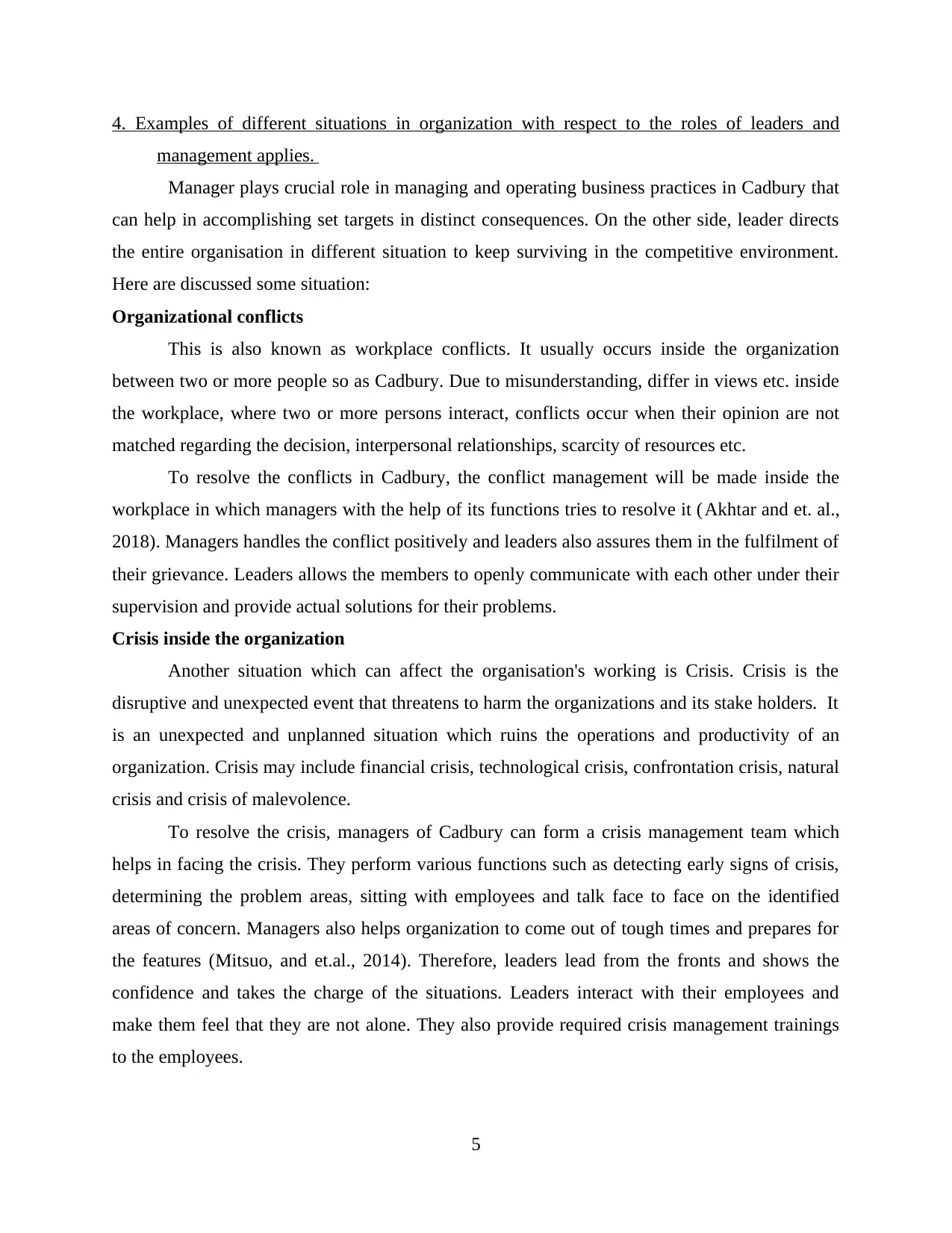
4. Examples of different situations in organization with respect to the roles of leaders and
management applies.
Manager plays crucial role in managing and operating business practices in Cadbury that
can help in accomplishing set targets in distinct consequences. On the other side, leader directs
the entire organisation in different situation to keep surviving in the competitive environment.
Here are discussed some situation:
Organizational conflicts
This is also known as workplace conflicts. It usually occurs inside the organization
between two or more people so as Cadbury. Due to misunderstanding, differ in views etc. inside
the workplace, where two or more persons interact, conflicts occur when their opinion are not
matched regarding the decision, interpersonal relationships, scarcity of resources etc.
To resolve the conflicts in Cadbury, the conflict management will be made inside the
workplace in which managers with the help of its functions tries to resolve it (Akhtar and et. al.,
2018). Managers handles the conflict positively and leaders also assures them in the fulfilment of
their grievance. Leaders allows the members to openly communicate with each other under their
supervision and provide actual solutions for their problems.
Crisis inside the organization
Another situation which can affect the organisation's working is Crisis. Crisis is the
disruptive and unexpected event that threatens to harm the organizations and its stake holders. It
is an unexpected and unplanned situation which ruins the operations and productivity of an
organization. Crisis may include financial crisis, technological crisis, confrontation crisis, natural
crisis and crisis of malevolence.
To resolve the crisis, managers of Cadbury can form a crisis management team which
helps in facing the crisis. They perform various functions such as detecting early signs of crisis,
determining the problem areas, sitting with employees and talk face to face on the identified
areas of concern. Managers also helps organization to come out of tough times and prepares for
the features (Mitsuo, and et.al., 2014). Therefore, leaders lead from the fronts and shows the
confidence and takes the charge of the situations. Leaders interact with their employees and
make them feel that they are not alone. They also provide required crisis management trainings
to the employees.
5
management applies.
Manager plays crucial role in managing and operating business practices in Cadbury that
can help in accomplishing set targets in distinct consequences. On the other side, leader directs
the entire organisation in different situation to keep surviving in the competitive environment.
Here are discussed some situation:
Organizational conflicts
This is also known as workplace conflicts. It usually occurs inside the organization
between two or more people so as Cadbury. Due to misunderstanding, differ in views etc. inside
the workplace, where two or more persons interact, conflicts occur when their opinion are not
matched regarding the decision, interpersonal relationships, scarcity of resources etc.
To resolve the conflicts in Cadbury, the conflict management will be made inside the
workplace in which managers with the help of its functions tries to resolve it (Akhtar and et. al.,
2018). Managers handles the conflict positively and leaders also assures them in the fulfilment of
their grievance. Leaders allows the members to openly communicate with each other under their
supervision and provide actual solutions for their problems.
Crisis inside the organization
Another situation which can affect the organisation's working is Crisis. Crisis is the
disruptive and unexpected event that threatens to harm the organizations and its stake holders. It
is an unexpected and unplanned situation which ruins the operations and productivity of an
organization. Crisis may include financial crisis, technological crisis, confrontation crisis, natural
crisis and crisis of malevolence.
To resolve the crisis, managers of Cadbury can form a crisis management team which
helps in facing the crisis. They perform various functions such as detecting early signs of crisis,
determining the problem areas, sitting with employees and talk face to face on the identified
areas of concern. Managers also helps organization to come out of tough times and prepares for
the features (Mitsuo, and et.al., 2014). Therefore, leaders lead from the fronts and shows the
confidence and takes the charge of the situations. Leaders interact with their employees and
make them feel that they are not alone. They also provide required crisis management trainings
to the employees.
5
Paraphrase This Document
Need a fresh take? Get an instant paraphrase of this document with our AI Paraphraser

5. Applying the different management and leadership theories for the support growth and
sustainable performance
Situational leadership
This leadership style was propounded by Kenneth Blanchard and Paul Heresy. In this,
theory of leadership, leaders adjust themselves according to the level of the followers or to the
particular situations. In situational leadership, leader have to change their own style instead of
changing their followers’ style in order to keep influencing them (Chakrabarti, 2014). In
situational leadership, leader may apply style as per the situation in the organization. The model
of situational leadership is based on the relationship between followers and leaders and serves as
a framework to analyse each situation. This theory of leadership is very much beneficial for the
sustainable growth of Cadbury as it creates a common language of performance and also teaches
leaders to accurately interpret and effectively responds to their environment.
Contingency leadership
The contingency theory was propounded by Austrian psychologist Fred Edward Fielder
in 1964. The theory put focus on the idea that success of a leader joint on the specific situation at
hand. It explains that there are some factors that can affect the relationship between independent
and dependent variables of organization. This theory depicts that leader is to be known as
effective when they direct themselves according to the situations. The contingency helps in
organization's sustainable growth as it motivates thinking about a particular aspect of a leader-led
situation that need more intense focus.
System leadership
It anticipates that all part bears relationship with all another part of the organisation and,
therefore, leader should view the Cadbury as a whole belongs to several inter-related parts. This
theory gives new thinking to the study of organisations and management (Leadership theories,
2018). It identifies simultaneous variations of mutually dependent variables of the organisation.
In present case leader can apply situational leadership style. This is because it will help in
making change in style according to situation. This will benefit employees as well as leader to
achieve goals in given time. Also, leader is able to maintain organisational culture.
6. Strengths and weaknesses of the various theories
Theories Strengths Weaknesses
Situational leaderships Situational leadership is For task oriented or
6
sustainable performance
Situational leadership
This leadership style was propounded by Kenneth Blanchard and Paul Heresy. In this,
theory of leadership, leaders adjust themselves according to the level of the followers or to the
particular situations. In situational leadership, leader have to change their own style instead of
changing their followers’ style in order to keep influencing them (Chakrabarti, 2014). In
situational leadership, leader may apply style as per the situation in the organization. The model
of situational leadership is based on the relationship between followers and leaders and serves as
a framework to analyse each situation. This theory of leadership is very much beneficial for the
sustainable growth of Cadbury as it creates a common language of performance and also teaches
leaders to accurately interpret and effectively responds to their environment.
Contingency leadership
The contingency theory was propounded by Austrian psychologist Fred Edward Fielder
in 1964. The theory put focus on the idea that success of a leader joint on the specific situation at
hand. It explains that there are some factors that can affect the relationship between independent
and dependent variables of organization. This theory depicts that leader is to be known as
effective when they direct themselves according to the situations. The contingency helps in
organization's sustainable growth as it motivates thinking about a particular aspect of a leader-led
situation that need more intense focus.
System leadership
It anticipates that all part bears relationship with all another part of the organisation and,
therefore, leader should view the Cadbury as a whole belongs to several inter-related parts. This
theory gives new thinking to the study of organisations and management (Leadership theories,
2018). It identifies simultaneous variations of mutually dependent variables of the organisation.
In present case leader can apply situational leadership style. This is because it will help in
making change in style according to situation. This will benefit employees as well as leader to
achieve goals in given time. Also, leader is able to maintain organisational culture.
6. Strengths and weaknesses of the various theories
Theories Strengths Weaknesses
Situational leaderships Situational leadership is For task oriented or
6
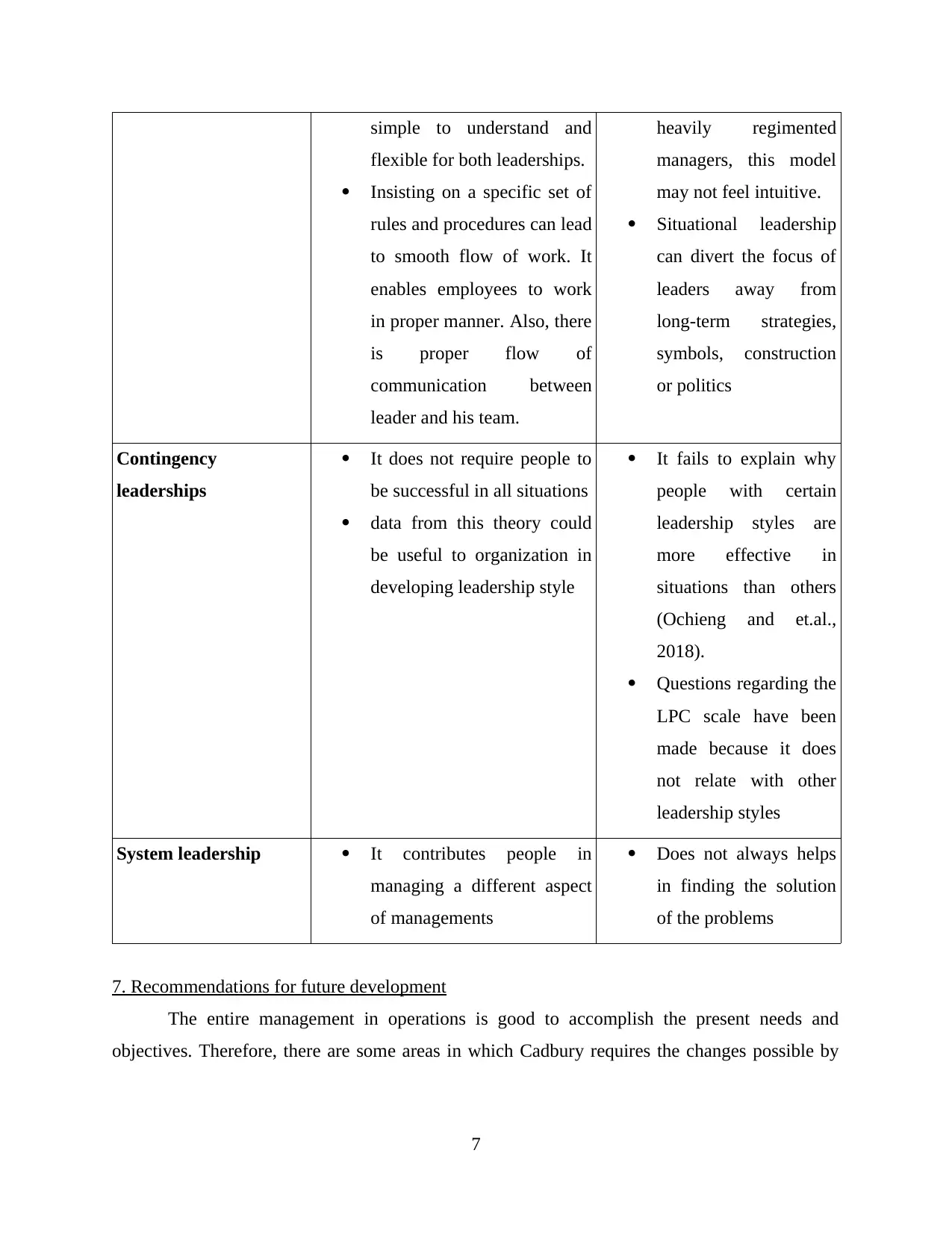
simple to understand and
flexible for both leaderships.
Insisting on a specific set of
rules and procedures can lead
to smooth flow of work. It
enables employees to work
in proper manner. Also, there
is proper flow of
communication between
leader and his team.
heavily regimented
managers, this model
may not feel intuitive.
Situational leadership
can divert the focus of
leaders away from
long-term strategies,
symbols, construction
or politics
Contingency
leaderships
It does not require people to
be successful in all situations
data from this theory could
be useful to organization in
developing leadership style
It fails to explain why
people with certain
leadership styles are
more effective in
situations than others
(Ochieng and et.al.,
2018).
Questions regarding the
LPC scale have been
made because it does
not relate with other
leadership styles
System leadership It contributes people in
managing a different aspect
of managements
Does not always helps
in finding the solution
of the problems
7. Recommendations for future development
The entire management in operations is good to accomplish the present needs and
objectives. Therefore, there are some areas in which Cadbury requires the changes possible by
7
flexible for both leaderships.
Insisting on a specific set of
rules and procedures can lead
to smooth flow of work. It
enables employees to work
in proper manner. Also, there
is proper flow of
communication between
leader and his team.
heavily regimented
managers, this model
may not feel intuitive.
Situational leadership
can divert the focus of
leaders away from
long-term strategies,
symbols, construction
or politics
Contingency
leaderships
It does not require people to
be successful in all situations
data from this theory could
be useful to organization in
developing leadership style
It fails to explain why
people with certain
leadership styles are
more effective in
situations than others
(Ochieng and et.al.,
2018).
Questions regarding the
LPC scale have been
made because it does
not relate with other
leadership styles
System leadership It contributes people in
managing a different aspect
of managements
Does not always helps
in finding the solution
of the problems
7. Recommendations for future development
The entire management in operations is good to accomplish the present needs and
objectives. Therefore, there are some areas in which Cadbury requires the changes possible by
7
⊘ This is a preview!⊘
Do you want full access?
Subscribe today to unlock all pages.

Trusted by 1+ million students worldwide
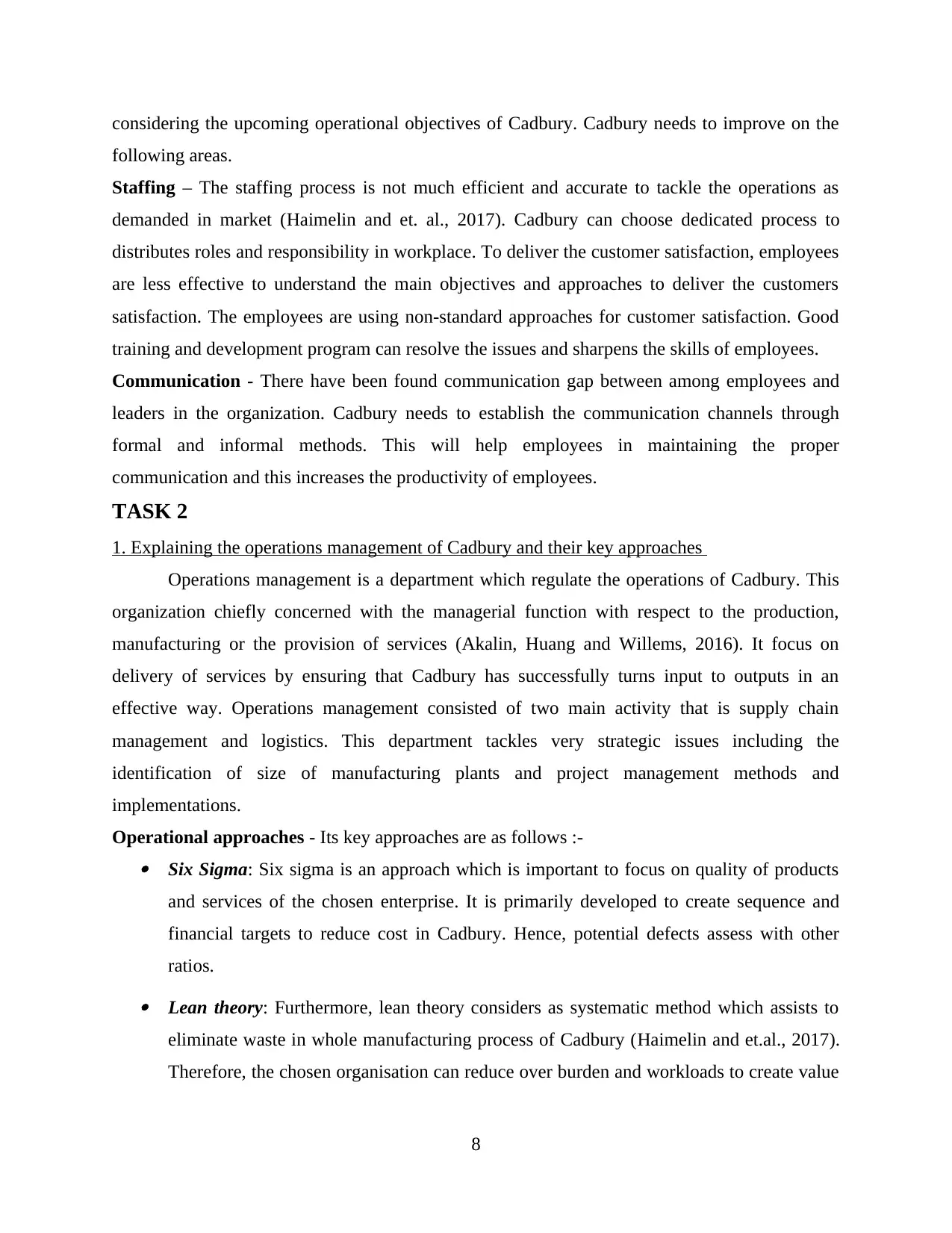
considering the upcoming operational objectives of Cadbury. Cadbury needs to improve on the
following areas.
Staffing – The staffing process is not much efficient and accurate to tackle the operations as
demanded in market (Haimelin and et. al., 2017). Cadbury can choose dedicated process to
distributes roles and responsibility in workplace. To deliver the customer satisfaction, employees
are less effective to understand the main objectives and approaches to deliver the customers
satisfaction. The employees are using non-standard approaches for customer satisfaction. Good
training and development program can resolve the issues and sharpens the skills of employees.
Communication - There have been found communication gap between among employees and
leaders in the organization. Cadbury needs to establish the communication channels through
formal and informal methods. This will help employees in maintaining the proper
communication and this increases the productivity of employees.
TASK 2
1. Explaining the operations management of Cadbury and their key approaches
Operations management is a department which regulate the operations of Cadbury. This
organization chiefly concerned with the managerial function with respect to the production,
manufacturing or the provision of services (Akalin, Huang and Willems, 2016). It focus on
delivery of services by ensuring that Cadbury has successfully turns input to outputs in an
effective way. Operations management consisted of two main activity that is supply chain
management and logistics. This department tackles very strategic issues including the
identification of size of manufacturing plants and project management methods and
implementations.
Operational approaches - Its key approaches are as follows :- Six Sigma: Six sigma is an approach which is important to focus on quality of products
and services of the chosen enterprise. It is primarily developed to create sequence and
financial targets to reduce cost in Cadbury. Hence, potential defects assess with other
ratios. Lean theory: Furthermore, lean theory considers as systematic method which assists to
eliminate waste in whole manufacturing process of Cadbury (Haimelin and et.al., 2017).
Therefore, the chosen organisation can reduce over burden and workloads to create value
8
following areas.
Staffing – The staffing process is not much efficient and accurate to tackle the operations as
demanded in market (Haimelin and et. al., 2017). Cadbury can choose dedicated process to
distributes roles and responsibility in workplace. To deliver the customer satisfaction, employees
are less effective to understand the main objectives and approaches to deliver the customers
satisfaction. The employees are using non-standard approaches for customer satisfaction. Good
training and development program can resolve the issues and sharpens the skills of employees.
Communication - There have been found communication gap between among employees and
leaders in the organization. Cadbury needs to establish the communication channels through
formal and informal methods. This will help employees in maintaining the proper
communication and this increases the productivity of employees.
TASK 2
1. Explaining the operations management of Cadbury and their key approaches
Operations management is a department which regulate the operations of Cadbury. This
organization chiefly concerned with the managerial function with respect to the production,
manufacturing or the provision of services (Akalin, Huang and Willems, 2016). It focus on
delivery of services by ensuring that Cadbury has successfully turns input to outputs in an
effective way. Operations management consisted of two main activity that is supply chain
management and logistics. This department tackles very strategic issues including the
identification of size of manufacturing plants and project management methods and
implementations.
Operational approaches - Its key approaches are as follows :- Six Sigma: Six sigma is an approach which is important to focus on quality of products
and services of the chosen enterprise. It is primarily developed to create sequence and
financial targets to reduce cost in Cadbury. Hence, potential defects assess with other
ratios. Lean theory: Furthermore, lean theory considers as systematic method which assists to
eliminate waste in whole manufacturing process of Cadbury (Haimelin and et.al., 2017).
Therefore, the chosen organisation can reduce over burden and workloads to create value
8
Paraphrase This Document
Need a fresh take? Get an instant paraphrase of this document with our AI Paraphraser
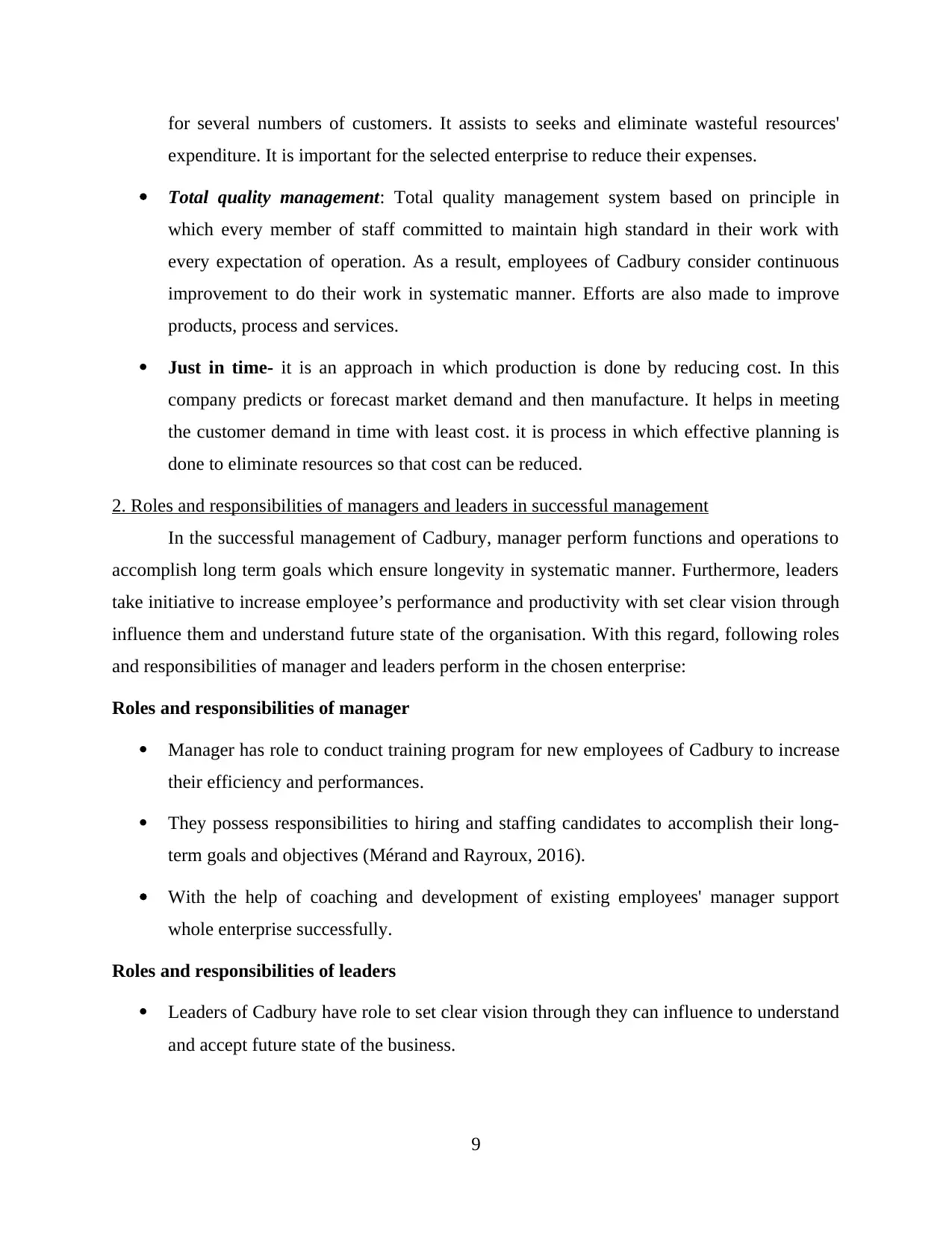
for several numbers of customers. It assists to seeks and eliminate wasteful resources'
expenditure. It is important for the selected enterprise to reduce their expenses.
Total quality management: Total quality management system based on principle in
which every member of staff committed to maintain high standard in their work with
every expectation of operation. As a result, employees of Cadbury consider continuous
improvement to do their work in systematic manner. Efforts are also made to improve
products, process and services.
Just in time- it is an approach in which production is done by reducing cost. In this
company predicts or forecast market demand and then manufacture. It helps in meeting
the customer demand in time with least cost. it is process in which effective planning is
done to eliminate resources so that cost can be reduced.
2. Roles and responsibilities of managers and leaders in successful management
In the successful management of Cadbury, manager perform functions and operations to
accomplish long term goals which ensure longevity in systematic manner. Furthermore, leaders
take initiative to increase employee’s performance and productivity with set clear vision through
influence them and understand future state of the organisation. With this regard, following roles
and responsibilities of manager and leaders perform in the chosen enterprise:
Roles and responsibilities of manager
Manager has role to conduct training program for new employees of Cadbury to increase
their efficiency and performances.
They possess responsibilities to hiring and staffing candidates to accomplish their long-
term goals and objectives (Mérand and Rayroux, 2016).
With the help of coaching and development of existing employees' manager support
whole enterprise successfully.
Roles and responsibilities of leaders
Leaders of Cadbury have role to set clear vision through they can influence to understand
and accept future state of the business.
9
expenditure. It is important for the selected enterprise to reduce their expenses.
Total quality management: Total quality management system based on principle in
which every member of staff committed to maintain high standard in their work with
every expectation of operation. As a result, employees of Cadbury consider continuous
improvement to do their work in systematic manner. Efforts are also made to improve
products, process and services.
Just in time- it is an approach in which production is done by reducing cost. In this
company predicts or forecast market demand and then manufacture. It helps in meeting
the customer demand in time with least cost. it is process in which effective planning is
done to eliminate resources so that cost can be reduced.
2. Roles and responsibilities of managers and leaders in successful management
In the successful management of Cadbury, manager perform functions and operations to
accomplish long term goals which ensure longevity in systematic manner. Furthermore, leaders
take initiative to increase employee’s performance and productivity with set clear vision through
influence them and understand future state of the organisation. With this regard, following roles
and responsibilities of manager and leaders perform in the chosen enterprise:
Roles and responsibilities of manager
Manager has role to conduct training program for new employees of Cadbury to increase
their efficiency and performances.
They possess responsibilities to hiring and staffing candidates to accomplish their long-
term goals and objectives (Mérand and Rayroux, 2016).
With the help of coaching and development of existing employees' manager support
whole enterprise successfully.
Roles and responsibilities of leaders
Leaders of Cadbury have role to set clear vision through they can influence to understand
and accept future state of the business.
9
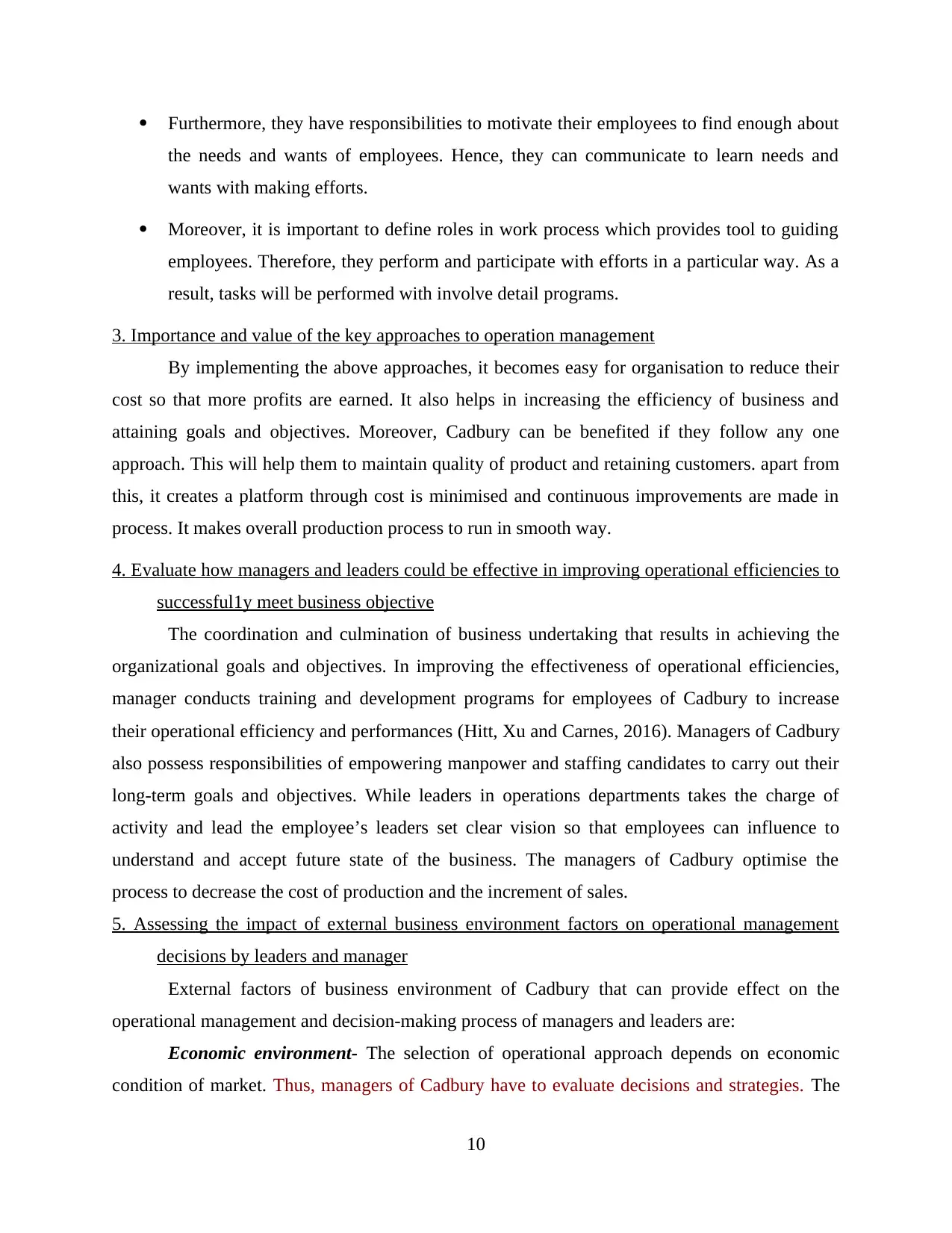
Furthermore, they have responsibilities to motivate their employees to find enough about
the needs and wants of employees. Hence, they can communicate to learn needs and
wants with making efforts.
Moreover, it is important to define roles in work process which provides tool to guiding
employees. Therefore, they perform and participate with efforts in a particular way. As a
result, tasks will be performed with involve detail programs.
3. Importance and value of the key approaches to operation management
By implementing the above approaches, it becomes easy for organisation to reduce their
cost so that more profits are earned. It also helps in increasing the efficiency of business and
attaining goals and objectives. Moreover, Cadbury can be benefited if they follow any one
approach. This will help them to maintain quality of product and retaining customers. apart from
this, it creates a platform through cost is minimised and continuous improvements are made in
process. It makes overall production process to run in smooth way.
4. Evaluate how managers and leaders could be effective in improving operational efficiencies to
successful1y meet business objective
The coordination and culmination of business undertaking that results in achieving the
organizational goals and objectives. In improving the effectiveness of operational efficiencies,
manager conducts training and development programs for employees of Cadbury to increase
their operational efficiency and performances (Hitt, Xu and Carnes, 2016). Managers of Cadbury
also possess responsibilities of empowering manpower and staffing candidates to carry out their
long-term goals and objectives. While leaders in operations departments takes the charge of
activity and lead the employee’s leaders set clear vision so that employees can influence to
understand and accept future state of the business. The managers of Cadbury optimise the
process to decrease the cost of production and the increment of sales.
5. Assessing the impact of external business environment factors on operational management
decisions by leaders and manager
External factors of business environment of Cadbury that can provide effect on the
operational management and decision-making process of managers and leaders are:
Economic environment- The selection of operational approach depends on economic
condition of market. Thus, managers of Cadbury have to evaluate decisions and strategies. The
10
the needs and wants of employees. Hence, they can communicate to learn needs and
wants with making efforts.
Moreover, it is important to define roles in work process which provides tool to guiding
employees. Therefore, they perform and participate with efforts in a particular way. As a
result, tasks will be performed with involve detail programs.
3. Importance and value of the key approaches to operation management
By implementing the above approaches, it becomes easy for organisation to reduce their
cost so that more profits are earned. It also helps in increasing the efficiency of business and
attaining goals and objectives. Moreover, Cadbury can be benefited if they follow any one
approach. This will help them to maintain quality of product and retaining customers. apart from
this, it creates a platform through cost is minimised and continuous improvements are made in
process. It makes overall production process to run in smooth way.
4. Evaluate how managers and leaders could be effective in improving operational efficiencies to
successful1y meet business objective
The coordination and culmination of business undertaking that results in achieving the
organizational goals and objectives. In improving the effectiveness of operational efficiencies,
manager conducts training and development programs for employees of Cadbury to increase
their operational efficiency and performances (Hitt, Xu and Carnes, 2016). Managers of Cadbury
also possess responsibilities of empowering manpower and staffing candidates to carry out their
long-term goals and objectives. While leaders in operations departments takes the charge of
activity and lead the employee’s leaders set clear vision so that employees can influence to
understand and accept future state of the business. The managers of Cadbury optimise the
process to decrease the cost of production and the increment of sales.
5. Assessing the impact of external business environment factors on operational management
decisions by leaders and manager
External factors of business environment of Cadbury that can provide effect on the
operational management and decision-making process of managers and leaders are:
Economic environment- The selection of operational approach depends on economic
condition of market. Thus, managers of Cadbury have to evaluate decisions and strategies. The
10
⊘ This is a preview!⊘
Do you want full access?
Subscribe today to unlock all pages.

Trusted by 1+ million students worldwide
1 out of 16
Related Documents
Your All-in-One AI-Powered Toolkit for Academic Success.
+13062052269
info@desklib.com
Available 24*7 on WhatsApp / Email
![[object Object]](/_next/static/media/star-bottom.7253800d.svg)
Unlock your academic potential
Copyright © 2020–2025 A2Z Services. All Rights Reserved. Developed and managed by ZUCOL.





